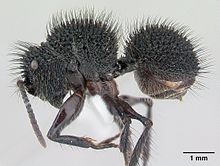
The Formicinae are a subfamily within the Formicidae containing ants of moderate evolutionary development.

Tapinoma is a genus of ants that belongs to the subfamily Dolichoderinae. The genus currently comprises 74 described species distributed worldwide in tropical and temperate regions. Members of are generalized foragers, nesting in a wide variety of habitats, ranging from grasslands, open fields, woodlands, to inside buildings. The majority of species nest in the ground under objects such as stones or tree logs, other species build nests under bark of logs and stumps, in plant cavities, insect galls or refuse piles.

Anonychomyrma is a genus of ants in the subfamily Dolichoderinae.

Crematogaster is an ecologically diverse genus of ants found worldwide, which are characterised by a distinctive heart-shaped gaster (abdomen), which gives them one of their common names, the Saint Valentine ant. Members of this genus are also known as cocktail ants because of their habit of raising their abdomens when alarmed. Most species are arboreal (tree-dwelling). These ants are sometimes known as acrobat ants.

Pseudomyrmex is a genus of stinging, wasp-like ants in the subfamily Pseudomyrmecinae. They are large-eyed, slender ants, found mainly in tropical and subtropical regions of the New World.

Tetramorium is a genus of ants in the subfamily Myrmicinae that includes more than 520 species. These ants are also known as pavement ants.

Myrmicaria is an ant genus within the subfamily Myrmicinae.

Anochetus is a genus of small, carnivorous ants found in the tropics and subtropics throughout the world.

Rhytidoponera is a large genus of ants in the subfamily Ectatomminae. The genus is known from Australia and Melanesia, with New Caledonia as the most eastern limit.

Cataulacus is a genus of ants in the subfamily Myrmicinae. The genus is distributed in the Paleotropical regions, mainly in the Afrotropics. Most species are found in forests, but a few are known from more open and arid habitats.

Podomyrma is a genus of ants in the subfamily Myrmicinae.

Vollenhovia is a genus of ants in the subfamily Myrmicinae.

Paratopula is a genus of ants in the subfamily Myrmicinae. The genus consists of arboreal species known from the Oriental and Indo-Australian regions. Little is known about their biology.

Pseudolasius is a genus of ants in the subfamily Formicinae. The genus is known from southern Asia to northern Australia, where it appears to be restricted to tropical areas. These ants are commonly known as twig ants due to their habit of nesting in twigs or hollow stems.

Pseudoneoponera is a ponerine genus of ants found from India to Australia, they are mostly non queen species, most of the species within the genus thrives on only gamergates.

Ponerini is a tribe of Ponerinae ants with 46 genera and 6 extinct genera.
















